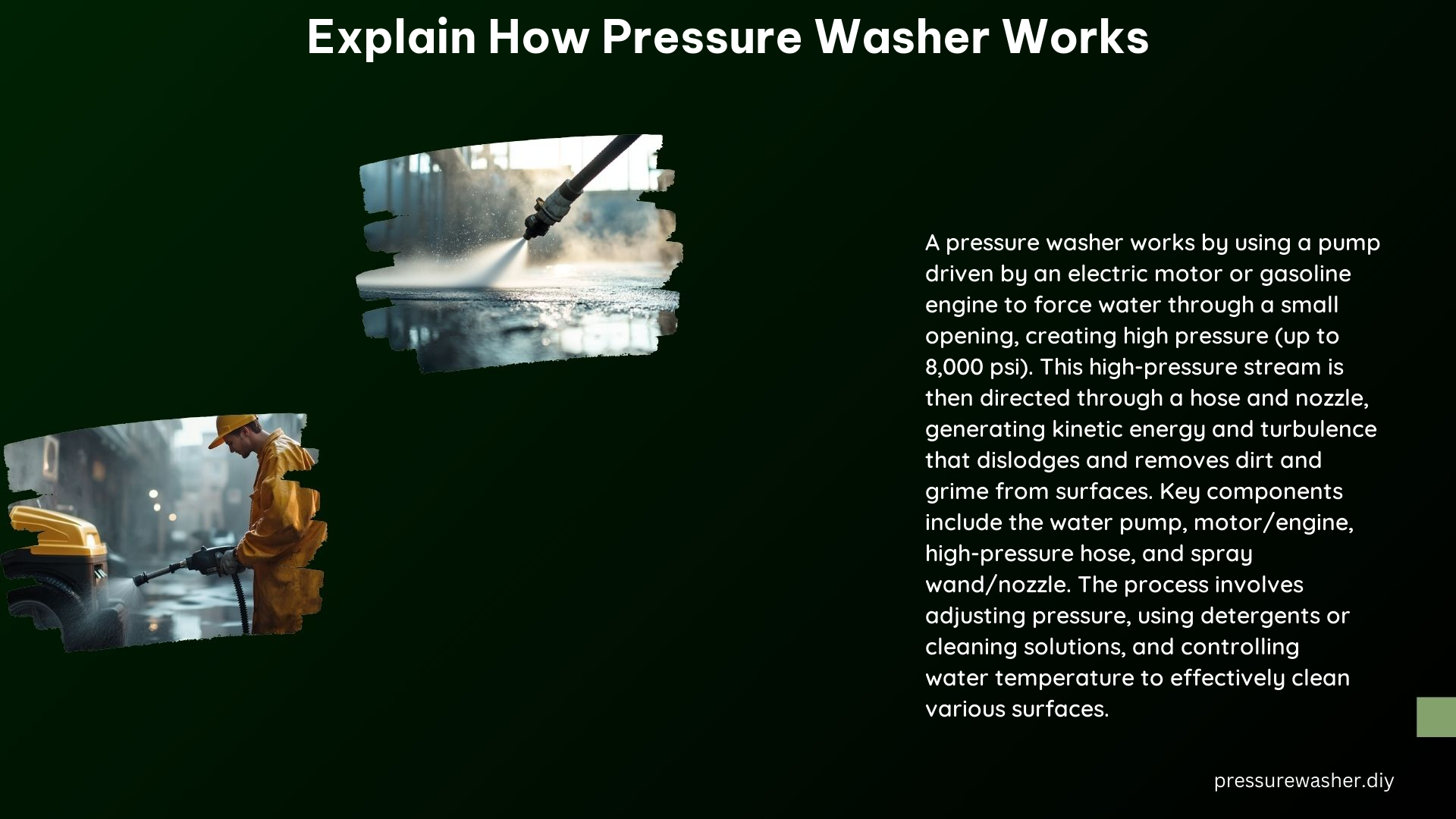A pressure washer is a versatile cleaning tool that utilizes high-pressure water jets to effectively remove dirt, grime, and other stubborn debris from a variety of surfaces. By understanding the intricate components and the underlying principles behind its operation, you can unlock the full potential of this powerful cleaning device and tackle even the toughest cleaning challenges with ease.
Components of a Pressure Washer
-
Water Inlet: The water inlet is the starting point of the pressure washer’s operation. It is typically a hose that connects the device to a water source, such as a faucet or a garden hose. This hose often includes a filter to prevent debris from entering the system and potentially damaging the internal components.
-
Electric Motor or Gas Engine: The power source that drives the water pump is either an electric motor or a gas-powered engine, depending on the size and intended use of the pressure washer. Smaller, domestic models often utilize electric motors, while larger, commercial-grade units are typically equipped with gas engines for increased power and mobility.
-
Water Pump: The heart of the pressure washer is the water pump. This component takes in the water from the inlet and increases its pressure, typically ranging from 1,000 to 4,000 pounds per square inch (psi). The pump is designed to handle a water flow rate of around 4 to 8 liters (1 to 2 gallons) per minute, ensuring efficient and effective cleaning.
-
High-Pressure Hose: The high-pressure hose is a reinforced, durable hose that connects the water pump to the spray gun. This hose is engineered to withstand the immense pressure generated by the pump, ensuring safe and reliable operation.
-
Spray Gun: The spray gun is the point of delivery for the pressurized water. It includes a trigger that allows the user to control the flow of water. The spray gun can be fitted with various nozzles, each designed to produce a specific spray pattern and pressure, enabling the user to tailor the cleaning performance to the task at hand.
How a Pressure Washer Works

-
Water Intake: The pressure washer’s operation begins with the water intake. Water is drawn from the inlet hose and into the pump.
-
Pressure Generation: The water pump is the key component responsible for increasing the water pressure. As the pump operates, it applies mechanical force to the water, raising its pressure to the desired level, typically between 1,000 and 4,000 psi.
-
High-Pressure Hose: The pressurized water is then directed through the high-pressure hose, which is designed to withstand the immense pressure without bursting or leaking.
-
Spray Gun: At the end of the high-pressure hose, the spray gun is the point of delivery for the pressurized water. As the user pulls the trigger, the water is forced through the nozzle, creating a powerful, concentrated stream that can effectively dislodge and remove dirt, grime, and other contaminants from the target surface.
Technical Specifications
-
Pressure Range: Pressure washers typically operate within a pressure range of 1,000 to 4,000 psi, with higher pressures generally providing more effective cleaning power.
-
Flow Rate: The flow rate of a pressure washer, measured in liters (or gallons) per minute, typically falls within the range of 4 to 8 liters (1 to 2 gallons) per minute. A higher flow rate can handle thicker dirt and grime more effectively, while a lower flow rate may be better suited for lighter cleaning tasks.
-
Minimum Water Pressure Required: The minimum water pressure required for a pressure washer to function effectively depends on the specific model and its intended use. Generally, a minimum pressure of around 30 psi is required for most domestic pressure washers to operate properly.
-
Impact of Flow Rate on Cleaning Performance: The flow rate of a pressure washer has a significant impact on its cleaning performance. A higher flow rate can handle thicker dirt and grime more effectively, as it provides a greater volume of water to dislodge and remove contaminants. Conversely, a lower flow rate may be better suited for lighter cleaning tasks, as it can be more precise and controlled.
DIY Tips for Pressure Washer Use
-
Follow Manufacturer’s Instructions: Always refer to the manufacturer’s instructions for the specific pressure washer model you are using. This ensures that you operate the device safely and effectively, while also maintaining its warranty and longevity.
-
Ensure Sufficient Water Supply: Make sure the water supply is adequate and the pressure washer is properly connected to the water source. Insufficient water flow can lead to damage to the pump and other internal components.
-
Use Appropriate Nozzles and Cleaning Agents: Select the appropriate nozzle and, if necessary, use recommended cleaning agents for the specific surface you are cleaning. This will optimize the cleaning performance and prevent damage to the surface.
-
Maintain the Pressure Washer: Regular maintenance, such as cleaning the filters, checking for wear and tear, and following the recommended service intervals, is crucial for maintaining the pressure washer’s optimal performance and extending its lifespan.
By understanding the intricate components and the underlying principles of how a pressure washer works, you can unlock its full potential and tackle even the toughest cleaning challenges with confidence and efficiency.
